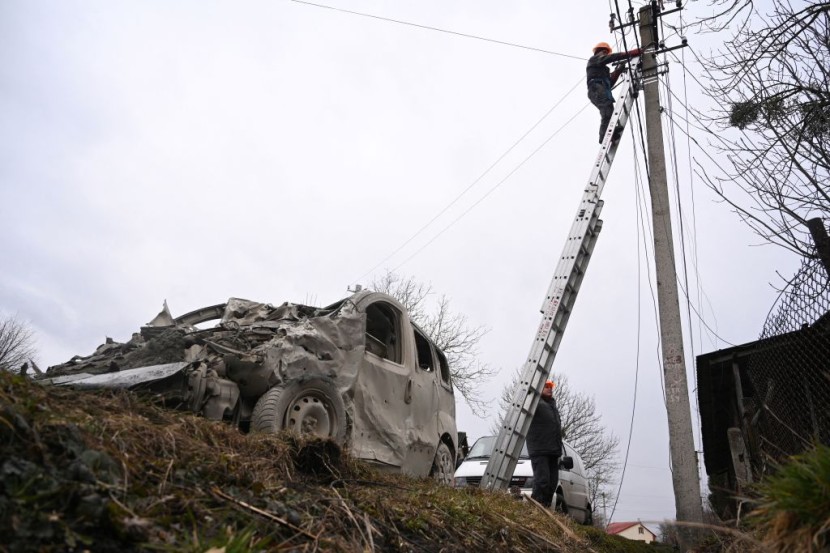
Russia employed formidable weaponry, including rare hypersonic missiles, in a fresh series of attacks across Ukraine, which resulted in the deaths of at least nine individuals.
According to reports, Russia has not used Kinzhal hypersonic missiles, which can bypass air defenses, since the conflict's earliest months. The current bombardment was the most intense to strike Ukraine in recent weeks.
Russia's Hypersonic Missiles
Afterward, electricity was restored to the Zaporizhzhia nuclear power facility, the largest in Europe. That was the largest day of Russian attacks on Ukraine since January's end. As per BBC, the Ukrainian military claimed to have destroyed 34 cruise missiles and four Shahed drones manufactured by Iran.
It also stated that it could not intercept the six Kinzhal ballistic missiles, as well as older weaponry such as Kh-22 anti-ship missiles and S-300 anti-aircraft missiles. The nuclear energy operator Energoatom stated that the attack at the Zaporizhzhia plant severed the facility's connection to the Ukrainian power grid.
The plant ran on diesel generators for the sixth time since Russia seized it a year ago until the connectivity was restored Thursday evening. Electricity is required for the cooling of radioactive materials at the facility.
After a series of attacks since the beginning of the invasion, he demanded an international commitment to secure the facility on Thursday. In the Ukrainian capital, emergency services responded to explosions in the western and southern regions.
According to the city's governor, Maksym Marchenko, a missile also struck an energy complex in the port city of Odesa, resulting in power outages. Residential areas were also affected. However, there were no recorded injuries.
The Ukrainian military claims to have repelled Russian advances on the besieged eastern city of Bakhmut, despite Russian claims that they had gained control of its eastern half.
Russia has attempted to seize Bakhmut for months, while both sides suffered huge losses in a stalemate. Western sources estimate that between 20,000 and 30,000 Russian soldiers have been killed or injured since the war for the Ukrainian city of Bakhmut began last summer. The numbers cannot be independently confirmed.
Hypersonic missiles are long-range, highly maneuverable weaponry capable of exceeding Mach 5 - five times the speed of sound, or more than one mile per second. Its velocity renders conventional air defense systems mostly ineffective since by the time ground-based radars identify them, they are already close to their intended target.
The United States and China are racing to develop and deploy hypersonic weapons. Several nations, including Australia, Brazil, France, Germany, India, Iran, Israel, Japan, North Korea, and South Korea, are also developing this technology.
The hypersonic vehicle transports its warhead to the lower space barrier atop a conventional long-range missile. Following separation, the spacecraft uses gravity to accelerate its journey back to Earth.
Per NY Times, the vehicle may be a glider or a cruise missile that uses gravity acceleration to activate a "scramjet" engine that propels it hundreds of miles further. The Kinzhal is unique. It is a modified variant of the Iskander short-range ballistic missile used by the Russian Army, which is meant to be launched from truck-mounted launchers on the ground.
If the missile is launched from a warplane at a high altitude rather than from the ground, it can require more fuel to achieve faster speeds. According to Russia, the Kinzhal is capable of Mach 10 and above speeds, allowing it to penetrate US anti-missile defense systems. According to the Pentagon, it is launched by MiG-31 aircraft.
Russia initially claimed to have used the Kinzhal in Ukraine in a strike on an underground weapons depot about a year ago and has occasionally claimed its usage after that.
Another hypersonic missile that Russia claims to possess is the cruise missile Zircon, which can be launched from ships. Nevertheless, Russia did not acknowledge testing the Zircon during the January drills President Vladimir V. Putin announced. It is still being determined whether it has ever been employed in battle.
Ihnat said that the Ukrainian military intelligence service believed that Moscow had fewer than 50 Kinzhals before the Thursday barrage. It is unknown why Russia launched six of them, perhaps more than a tenth of its overall arsenal.
Yet, Russia may be able to replenish the Kinzhals. As the Kinzhal is only a modified version of an existing missile, it may be simpler to create than Zircons, which must be constructed from scratch.
Vladimir Putin Becomes Desperate
According to The Sun, the most recent major missile attack by Russia clearly indicates President Vladimir Putin's growing desperation. Having failed to prevail on the battlefield, Russia attempts to destroy Ukraine's fighting spirit.
Since October, missiles and drones launched from submarines, ships, ground launchers, and aircraft have battered the nation's energy infrastructure. Kremlin desires to engulf Ukraine in chilly gloom. If the electricity goes out, there will be no light. There is no heating at the pumping stations.
Despite the terrible strikes, the infrastructure continues to function. In some respects, it is even becoming better. The northern Ukrainian city of Kharkiv re-lit its streets for the first time since Russia's invasion on Wednesday evening, hours before the latest bombing.
Since February 23 of last year, a big flagpole with a Ukrainian flag has not been illuminated at night in the city center. Moreover, electric trains and trolley buses have resumed service. As retaliation for destroying the Kerch Bridge, which connects Russia to seized Crimea, Russian attacks on the energy infrastructure began in October.
Now, six months later, it is another Russian policy that failed. Kramatorsk, located barely 20 miles from the so-called "meat grinder" attack in Bakhmut, has enjoyed 24-hour power and running water for the past two weeks. It is the same narrative throughout the majority of Ukraine. Fortunately, the winter has been mild in Kyiv.
Related Article: Russia Launches Massive Missile Strikes Across Ukraine
@YouTube
© 2026 HNGN, All rights reserved. Do not reproduce without permission.








